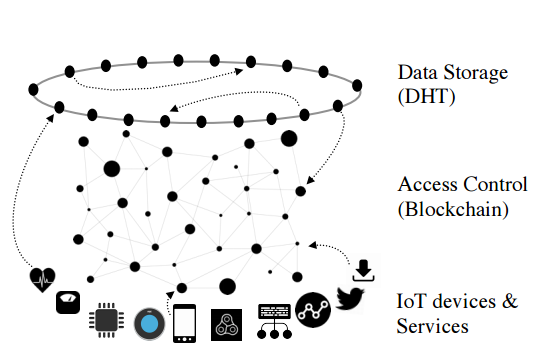The cloud is currently playing a pivotal role in the storage, processing and distribution of data. Even though it has contributed greatly to the development of a myriad of applications, including the IoT, the presently adopted centralized storage framework has ignited the emergence of a wide array of isolated data silos, and is holding back holistic data driven analytics of IoT frameworks from reaching their full potential. On the other hand, the blockchain technology is increasingly becoming an ideal security model that can not only maximize the security of cryptocurrencies, but also a large number of other applications including multi-party computing platforms, issuance of governmental id documents, management of medical records and others.
A team of developers proposed recently a prototype design of a blockchain based end-to-end encrypted system for storage of data on IoT that is centered on heightened security levels, resilience, auditable protection and sharing of information. Through their recently published paper, the team of developers introduced a system that enables secure data management, via utilization of the blockchain as a form of an auditable layer for access control to a decentralized storage layer.
The Internet of Things
With the advent of smart devices that have networking capabilities, which are referred to as IoT, we have recently witnessed a myriad of innovative applications across various arenas, including fitness, healthcare and transportation. The presently available framework of IoT is mainly comprised of low power smart devices that are equipped with the sensors that are responsible for the collection of high resolution data from their surrounding environments. This data is then secured via third party storage providers for further computation. To rephrase it, each application presents its group of devices and unique computational processes that will modify the data collected to provide a predefined service.
Resorting to third parties results in many problems, especially that users literally have no control over their stored data. Users have to confide in the cloud administrators, software and hardware to reliably keep their data safe. These limitation were the inspiration to the new blockchain based approach:
A New Blockchain Based Approach for IoT Management:
The aforementioned limitations necessitate a brand new approach for thinking about how IoT data should be handled. So, instead of simply storing data on central data centers, a data-centric approach is adopted to abstract away the location of data storage. The below figure shows how the system delineates the data plane from access control. Peers on the proposed distributed cloud can be incentivized with cryptocurrency rewards, such as Storj and/or FileCoin, for providing persistent storage space. Peers can be in the form of individual users, who donate their available storage space, or even cloud storage providers. Accordingly, peers cannot have any insights regarding the data hosted using their storage space.

The IoT data represents a stream that includes continuous generation of data records. This means that current decentralized storage approaches, which usually operate to archive data, are not suitable for IoT. So, instead of storing records of data, the new approach acts via storing chunks of data which are comprised of multiple consecutive records of data. As such, data stream is abstracted into chunks of data. Even though data chunking, prevents gaining random access to the record level, it positively influences how data is retrieved, especially that queries usually require data that belong to a specific time window, e.g. records of the past 24 hours.
The new system relies on Distributed Hash Table (DHT) as the interface for storing private key value data. DHT represents a scalable, highly available, self managing storage approach that enforces random storage using a 256 bit address space.
Image source:
http://www.simonduquennoy.net/papers/shafagh17towards-blockchain.pdf


